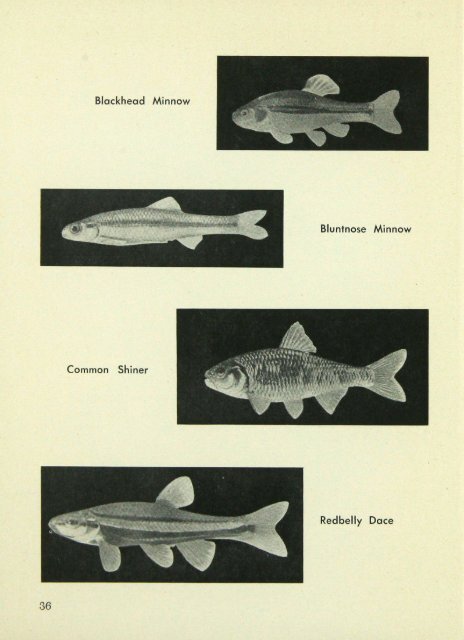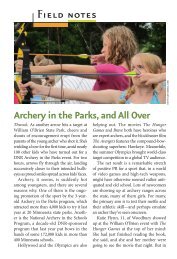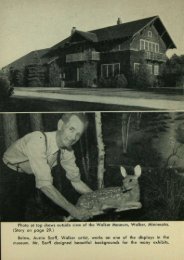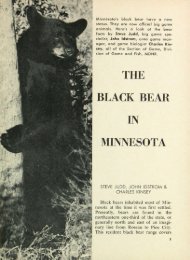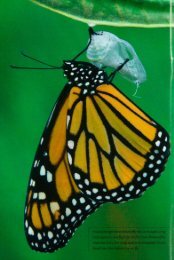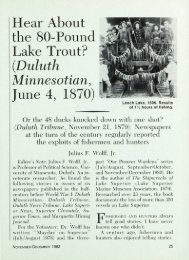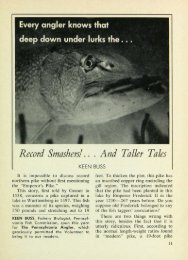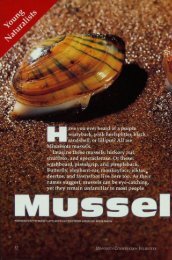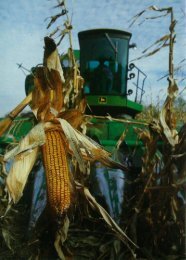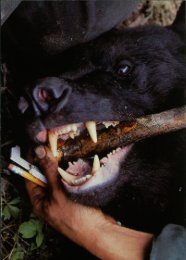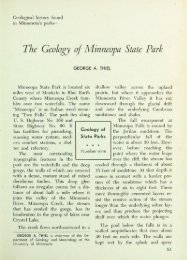4725 Artificial Propagation Needed to Relieve Minnow ... - webapps8
4725 Artificial Propagation Needed to Relieve Minnow ... - webapps8
4725 Artificial Propagation Needed to Relieve Minnow ... - webapps8
You also want an ePaper? Increase the reach of your titles
YUMPU automatically turns print PDFs into web optimized ePapers that Google loves.
36<br />
Common Shiner<br />
Bluntnose <strong>Minnow</strong><br />
Redbelly Dace
About 2,890,000 minnows are<br />
sold <strong>to</strong> fishermen each week.<br />
<strong>Artificial</strong> <strong>Propagation</strong> <strong>Needed</strong><br />
To <strong>Relieve</strong> <strong>Minnow</strong> Shortage<br />
A large percentage of <strong>to</strong>urists<br />
come <strong>to</strong> Minnesota in order <strong>to</strong><br />
<strong>to</strong> enjoy the good fishing of<br />
our 10,000 lakes. They arrive in such<br />
numbers that the <strong>to</strong>urist business is<br />
the third largest in the state.<br />
The sale of minnows and<br />
suckers for bait is an important<br />
part of this business.<br />
There are about 1,700 retail<br />
and 150 wholesale dealers<br />
in operation each year.<br />
The 1,700 retail bait dealers have<br />
an average sale of about one gallon<br />
of minnows a week. The number of<br />
minnows in a gallon varies according<br />
<strong>to</strong> the size of the fish but 1,700 is<br />
an average number. Therefore, about<br />
2,890,000 minnows are sold <strong>to</strong> the<br />
fishermen each week of the 17 or 18<br />
week season. While this is a tremendous<br />
figure, it does not include the<br />
fish that are killed during seining<br />
operations or those that are lost in<br />
transportation and holding of the fish.<br />
This heavy drain on the natural supply<br />
of bait fishes has resulted in<br />
many periods of acute minnow shortage.<br />
The natural habits of the minnows<br />
have contributed <strong>to</strong> this shortage.<br />
John Dobie<br />
<strong>Propagation</strong><br />
of<br />
<strong>Minnow</strong>s<br />
ftumlte'i One<br />
When spawning, these little fish congregate<br />
along the lake shores and in<br />
streams where they are easy <strong>to</strong> seine.<br />
The bait dealer can then obtain all<br />
that he wants but there is very little<br />
demand for minnows early<br />
in the spring. By midsummer<br />
when the demand is<br />
large, the fish have spread<br />
over the lake and are difficult<br />
<strong>to</strong> catch in large quantities.<br />
Some dealers have<br />
solved the problem by building or<br />
leasing ponds large enough <strong>to</strong> hold a<br />
supply from spring <strong>to</strong> midsummer.<br />
The geographical distribution of<br />
fishes has further complicated the<br />
shortage of bait. The demand for<br />
bait fishes is heaviest in the northern<br />
resort area where the deep lakes and<br />
cold streams do not produce large<br />
quantities of minnows. Consequently,<br />
large numbers must be hauled hundreds<br />
of miles from the warm southern<br />
lakes where the production is<br />
high and the demand is low. Most<br />
of the long hauls are during hot<br />
weather and the losses are high.<br />
A supply of minnows is necessary<br />
<strong>to</strong> provide forage for the large game<br />
fish populations of our lakes and is<br />
37
38 THE CONSERVATION VOLUNTEER<br />
so important <strong>to</strong> the sport fishing industry<br />
that the Game and Fish Division<br />
has developed a program of<br />
regulations <strong>to</strong> safeguard this resource.<br />
In lakes and streams where the taking<br />
of minnows has endangered the<br />
game fish populations, the seining of<br />
minnows has been prohibited. Exact<br />
specifications on net mesh size, type<br />
of transportation equipment that can<br />
be used, minimum aeration requirements<br />
for transportation and holding<br />
tanks, and maximum load capacity<br />
for these tanks have been formulated<br />
in order <strong>to</strong> eliminate much of the loss<br />
that occurs when minnows are handled.<br />
Some shallow lakes have been<br />
set aside as minnow lakes <strong>to</strong> be managed<br />
entirely for bait fishes. A few<br />
have required s<strong>to</strong>cking and others<br />
needed <strong>to</strong> be closed for one or more<br />
seasons but all are opened <strong>to</strong> commercial<br />
fishing whenever the fish<br />
population is large enough <strong>to</strong> justify<br />
that action. The operation of these<br />
lakes is an important step in improving<br />
the bait situation.<br />
If the present trend of closing waters<br />
<strong>to</strong> the taking of minnows con-<br />
JOHN DOBIE is an aquatic biologist with<br />
the Bureau of Fisheries Research of the Division<br />
of Game and Fish, with which he has<br />
been associated since 1940. He previously was<br />
employed by the U.S. Forest Service, the Wisconsin<br />
Conservation Department, and as a<br />
wildlife technician with the Minnesota ECW<br />
program. He is one of the authors of Care<br />
and Raising of Baits (see last paragraph of<br />
article). This is the first of a series of four<br />
articles.<br />
tinues, the dealers may find themselves<br />
in the same situation that exists<br />
in Missouri where all the game<br />
fish waters of the state are closed.<br />
In the northern part of the state<br />
where there are very few lakes that<br />
can be managed entirely for minnows,<br />
the bait dealer will find it necessary<br />
<strong>to</strong> raise his own supply in<br />
ponds. For many years dealers have<br />
been raising bait fishes in both natural<br />
and artificial ponds and some have<br />
produced over 200,000 minnows per<br />
acre.<br />
There are many advantages in<br />
minnow propagation.<br />
(1) The dealer can raise the species<br />
of fish most suited <strong>to</strong> his trade.<br />
(2) The dealer can be more sure<br />
of a regular supply of minnows of<br />
suitable size.<br />
(3) Since the minnows are always<br />
available, they do not have <strong>to</strong> be<br />
seined up in large quantities with<br />
the resulting loss from handling and<br />
holding of large numbers.<br />
(4) The fisherman will be able <strong>to</strong><br />
obtain a better conditioned bait and<br />
one that is more suited <strong>to</strong> his needs.<br />
(5) The cost of raising minnows<br />
will often be less than seining and<br />
transporting them from distant waters.<br />
In Minnesota, an increasing number<br />
of dealers have become interested<br />
in raising minnows, so the Game and<br />
Fish Division has cooperated with<br />
the Wisconsin and Michigan Departments<br />
and the U. S. Fish and Wild-
ARTIFICIAL PROPAGATION NEEDED 39<br />
life Service in putting out a bulletin<br />
on the propagation of bait fishes. It<br />
is written <strong>to</strong> present all of the available<br />
information on the subject and<br />
<strong>to</strong> help the beginner over his first<br />
difficulties. There are many questions<br />
that cannot be answered at the present<br />
time, but when the answers are<br />
available, the bulletin will be revised<br />
<strong>to</strong> include them. Persons desiring <strong>to</strong><br />
receive this publication, when issued,<br />
should address a request <strong>to</strong> be put on<br />
the waiting list for Care and Raising<br />
of Baits <strong>to</strong> the Bureau of Fisheries<br />
Research, 355 Shubert Bldg., St.<br />
Paul 2.<br />
NATURE INTERPRETATION PROJECT<br />
It has been definitely established that the best situations in which<br />
<strong>to</strong> acquaint people with correct conservation relationships and nature<br />
facts, generally are the localities wherein wild plants, wild animals,<br />
and geological features naturally exist. With this in mind, it is recalled<br />
that rich, undeveloped opportunities for visualizing vital conservation<br />
concepts and conducting true nature interpretation projects exist in<br />
many of our Minnesota state parks. Nearly two million people visit<br />
these natural areas annually and few of the visi<strong>to</strong>rs possess more<br />
than a small understanding of the conservation essentials, or more<br />
than a minute knowledge of the fascinating nature lore commonly<br />
found there. In order <strong>to</strong> utilize these educational opportunities, the<br />
Minnesota Museum of Natural His<strong>to</strong>ry, University of Minnesota, and<br />
the Division of State Parks, Minnesota Department of Conservation,<br />
are inaugurating a nature interpretation project this summer at<br />
Itasca State Park. This work will be conducted by a resident park<br />
naturalist from the Museum staff. The educational activities will be<br />
offered through regularly scheduled field trips, self-guiding nature<br />
trails, small museum exhibits, nature talks and film showings at Forest<br />
Inn and the Camp ground. It is also planned <strong>to</strong> provide some nature<br />
guide and nature lecture service at selected periods during the<br />
summer in the St. Croix State Park.


